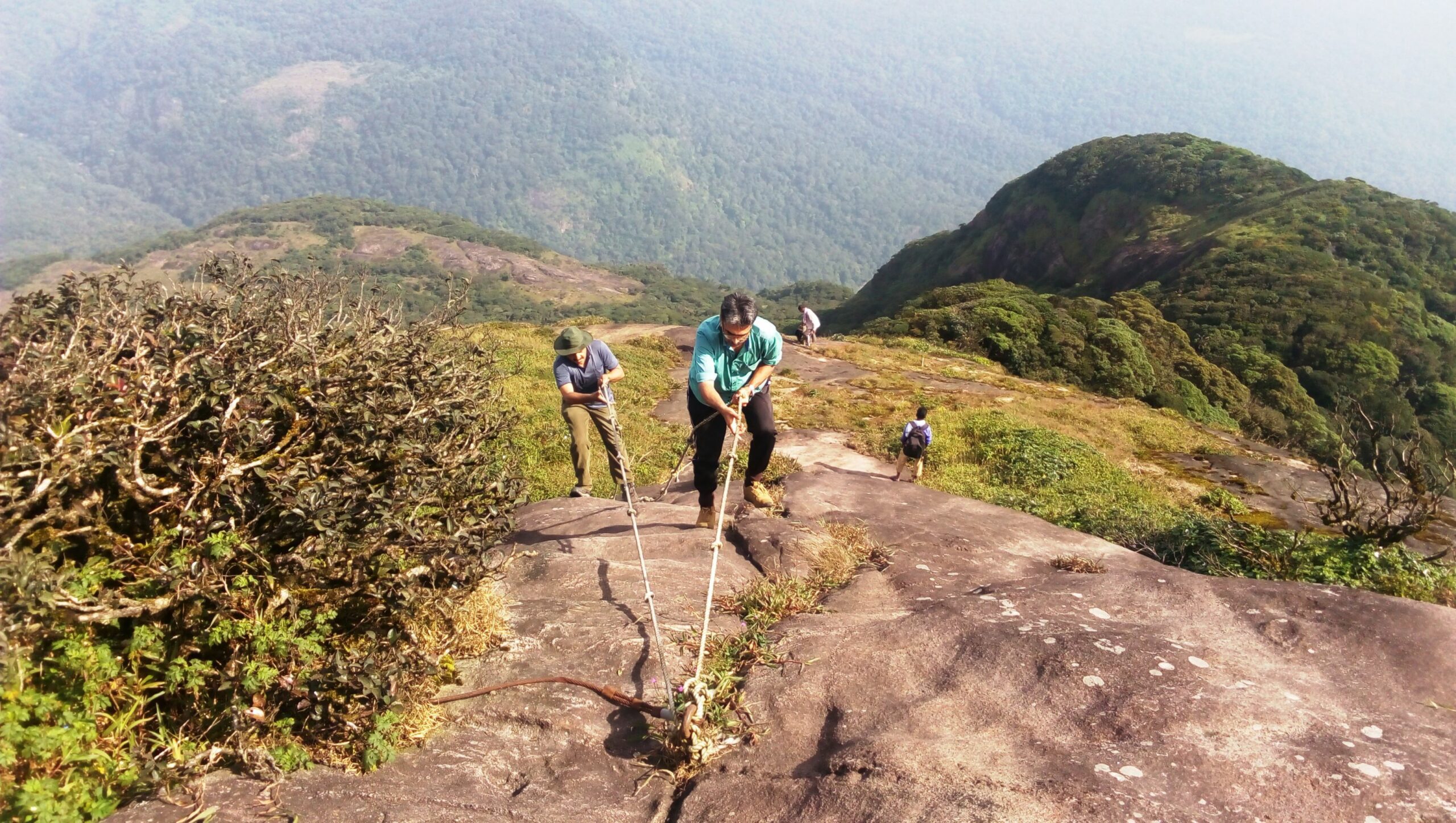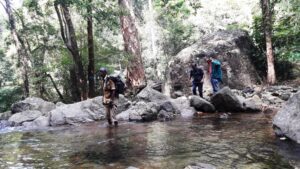
Trekkers climb the Agasthyakoodam located inside the Neyyar Wildlife Sanctuary. (KA Shaji/South First)
The Agasthyarkoodam trekking season in the southernmost forests of Kerala will begin on 16 January this year with renewed vigour after almost three years of coronavirus-induced restrictions on the number of participants.
As the online booking for the month-long annual event is slated to begin on 5 January, there are indications that thousands of women trekkers from across India will climb the peak named after the Hindu sage Agasthya — who, according to legend, was a celibate.
The second-highest peak in Kerala, Agasthyarkoodam was out of bounds for women trekkers till 2019, when the Kerala High Court lifted the ban terming it discriminatory and against the spirit of gender justice.
While a similar ban exists in Kerala’s top pilgrim centre, Sabarimala, the Kani tribals who live in and around Agasthyarkoodam decided to respect the court order and forgo their long-held belief that Sage Agasthya would not be comfortable if women entered his tranquil and picturesque abode, which is also a treasure trove of biodiversity.
Empowered by the court order, over 3,500 women undertook the arduous trek in 2019. This year, the Forest Department expects at least 30,000 trekkers to apply — a third of them women.
“Agasthyarkoodam is a veritable storehouse of biodiversity, and climbing to the top of the peak means a trek without any parallel. The view from the top is exhilarating,” said K Dhanya Sanal, an official with the Defence Ministry, who became the first woman to hike up the 1,868-metre mountain following the lifting of restrictions.
A year after Dhanya conquered the peak, 62-year-old Nagaratnamma from Bengaluru climbed the hill, breaking barriers of age and health.
According to Thiruvananthapuram-based wildlife photographer Rahana Habeeb, the trek was a fantastic experience as the forest tracts were scenic and abundant with Arogyapacha plants, chewing whose leaves ensures quick rejuvenation.
“Agasthyarkoodam is a paradise for bird watchers, and most people use this trek to sight of exotic avian species. It is also home to 2,000 species of flora, including lichens, orchids, mosses and ferns,” said Rahana.
“It’s a highly monitored trek that would not cause any harm to the fragile ecology of the southern edge of the Western Ghats. The passion for the forest and the wild brings us here rather than any preconceived notions of gender considerations,” she said.
But for Divya Divakaran, school teacher and secretary of Women Integration and Growth Through Sports (WINGS), the gender justice now visible at Agasthyarkoodam is the outcome of a protracted legal battle seeking respect for women.
It was her efforts, knocking on doors of courts and government offices, that finally yielded results.
“We are waiting for the online booking to start. The tribe of women trekkers is fast increasing, and climbing Agasthyakoodam is significant to them as it has the dubious legacy as one of the crumbled bastions of gender discrimination,” says Seema Suresh Neelambari, a Thrissur-based wildlife photographer.
The court order had evoked angry reactions initially from the Kani tribals who live on the slopes and foothills of the Agasthyarkoodam mountains, which are spread across the Thiruvananthapuram and Kollam districts of Kerala and Thirunelveli and Kanyakumari districts of Tamil Nadu.
Saying women’s entry would affect the celibacy of Agasthya, who is said to keep the hills safe, the Kanis even organised a series of “Namajapa” protests condemning the Forest Department decision welcoming women trekkers.
Namajapa was a kind of protest that evolved in Sabarimala, where Sangh Parivar elements tried to disrupt court-ordered women’s entry by chanting the names of Lord Ayyappa.
However, the community decided against preventing women trekkers forcibly, as in the case of Sabarimala.
The Kani community, which conducted an Achara Samrakshana Yagna (a religious ritual meant to protect traditions) on the day women began their trek to the hills, is now a changed lot.
“We respected the court order. Irrespective of their gender, nobody can touch or come close to the idol of Sage Agasthya installed on top. So we feel there is nothing wrong in people reaching and watching the idol from a clear distance,” said T Mohan, president of Agasthyarkoodam Kshethra Kanikkar Trust.
While lifting the gender-based ban on women trekkers, judge Anu Sivaraman of Kerala High Court made it clear that even if Kanis possess certain religious rights over the Agasthyarkoodam, they be against the fundamental human rights of women to participate in the annual trek.
The judge had prevented trekkers, irrespective of gender, from entering the immediate vicinity of the forest temple of Agasthya and offering religious rituals. She clarified that the temple would continue to be under the exclusive control of the Kani tribals.
Divya recalled that the legal battle to lift the restrictions on the entry of women to Agasthyarkoodam was hard-fought.
Almost a decade ago, her organisation had noticed that forest officials had issued a notification preventing women and children from participating in the two-day hike comprising an overnight stay in a spartan base camp.
When women’s collectives Pennoruma, headed by M Sulfath, and Anweshi, led by former Naxalite K Ajitha, joined hands with WINGS in the court battle to challenge the gender bias, the issue began getting wide attention.
Till 2019, the organisations had held demonstrations in front of the government secretariat and the Forest Department headquarters, demanding the lifting of the ban. They had also repeatedly petitioned the government, but to no avail.
However, their legal fight bore fruit finally in 2019, allowing women to climb the holy hills, home also to some 2,000 varieties of rare medicinal plants.
According to forest officials, the department has erected barricades around the forest temple to facilitate undisturbed puja by Kani community members on Sivarathri night and during all other auspicious occasions. They said that no Kani ritual would be disturbed by the presence of trekkers.
Forest officials said only a limited number of passes would be issued — on a first come, first served basis — given the fragile ecology of the mountain. In the bookings, there is no separate quota for women.

Forest officials inspecting the trekking route. Photo: K A Shaji
As in the case of Ayyappa, Sage Agasthya is considered a celibate. That’s the reason why Kanis object to women’s entry.
Several hymns in the vedas are attributed to the sage, who also makes an appearance in both the Ramayana and Mahabharata epics. He is said to have chosen the Agasthyarkoodam as his final resting place.
For the Kanis, though, the sage is “Mootha Kani”, or “King of Kanis”.
The trekking this year will end by February 15.
Each participant would be charged a fee of ₹1,800, which includes ₹300 as an eco-management special fee. Only those over 14 years would be permitted and must produce fitness certificates from registered medical practitioners issued seven days before the trek.
Those in the age group of 14 and 18 years will also have to submit consent letters from their parents or guardians.
Bookings can be made at: https://forest.kerala.gov.in/index.php/take-a-walk-to-the-wild?id=548

Jul 26, 2024

Jul 26, 2024

Jul 25, 2024

Jul 25, 2024

Jul 25, 2024

Jul 24, 2024